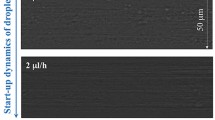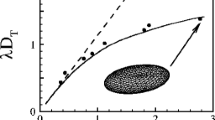Abstract
The effect of interfacial tension on the steady-flow and dynamic viscoelastic behavior of emulsions are studied experimentally. At very low inter-facial tensions and low volume fractions, the viscosity decreases with increasing shear rate and becomes constant at high shear rates. The high-shear-rate Newtonian viscosity is not affected by interfacial tension, but the transition from pseudoplastic to Newtonian flow shifts to lower shear rates as the interfacial tension decreases. At an interfacial tension of 5 × 10–3 Nm−1, the viscosity decreases, passes through a minimum, and then increases as the shear rate is increased. The dilatant behavior may be attributed to elastic responses of interfaces during collision of drops. At high volume fractions, the emulsions show remarkable elasticity resulting from the interfacial energy associated with deformation of liquid films. The modulus and viscosity are proportional to interfacial tension and inversely proportional to drop size.
Similar content being viewed by others
References
Almgren M, Van Stam J, Swarup S, Lofroth JE (1986) Structure and transport in the microemulsion phase of the system Triton X-100-toluene-water. Langmuir 2:432–438
Chaffey CE, Wagstaff I (1977) Shear thinning and thickening rheology. II. Volume fraction and size of dispersed particles. J Colloid Interface Sci 59:63–75
Flumerfelt RW (1980) Effects of dynamic interfacial properties on drop deformation and orientation in shear and extensional flow fields. J Colloid Interface Sci 76: 330–349
Hoffman RL (1972) Discontinuous and dilatant viscosity behavior in concentrated suspensions. I. Observation of a flow instability. Trans Soc Rheol 16:155–173
Hoffman RL (1974) Discontinuous and dilatant viscosity behavior in concentrated suspensions. II. Theory and experimental tests. J Colloid Interface Sci 46:491–506
Khan SA, Armstrong RC (1986) Rheology of foams. I. Theory for dry foams. J Non-Newt Fluid Mech 22:1–22
Khan SA, Armstrong RC (1987) Rheology of foams. II. Effects of polydispersity and liquid viscosity for foams having gas fraction approaching unity. J Non-Newt Fluid Mech 25:61–92
Khan SA, Schnepper CA, Armstrong RC (1988) Foam rheology. III. Measurements of shear flow properties. J Rheol 32:69–92
Kraynik AM, Hansen MG (1986) Foam and emulsion rheology. A quasistatic model for large deformations of spatially-periodic cells. J Rheol 30:409–439
Krieger IM, Choi GN (1984) Rheology of sterically stabilized dispersions. In: Mena B, Garcia-Rejon A, RangelNafaile C (eds) Advances in rheology, Vol 2. Universidad Nacional Autonoma de Mexico, Mexico City
Otsubo Y, Prud'homme RK (1992) Flow behavior of oilin-water emulsions. J Soc Rheol Japan 20:125–131
Phillips WJ, Graves RW, Flumerfelt RW (1980) Experimental studies of drop dynamics in shear fields. Role of dynamic interfacial effects. J Colloid Interface Sci 76:350–370
Princen HM (1979) Highly concentrated emulsions. I. Cylindrical systems. J Colloid Interface Sci 71:55–66
Princen HM (1983) Rheology of foams and highly concentrated emulsions. I. Elastic properties and yield stress of a cylindrical model system. J Colloid Interface Sci 91:160–175
Princen HM (1985) Rheology of foams and highly concentrated emulsions. II. Experimental study of the yield stress and wall effects for concentrated oil-in-water emulsions. J Colloid Interface Sci 105:150–171
Princen HM, Aronson MP, Moser JC (1980) Highly concentrated emulsions. II. Real systems. The effect of film thickness and contact angle on the volume fraction in creamed emulsions. J Colloid Interface Sci 75:246–270
Princen HM, Kiss AD (1986) Rheology of foams and highly concentrated emulsions. III. Static shear modulus. J Colloid Interface Sci 112:427–437
Strivens TA (1976) The shear thickening effect in concentrated dispersion systems. J Colloid Interface Sci 57:476–487
Wagstaff I, Chaffey CE (1977) Shear thinning and thickening rheology. I. Concentrated acrylic dispersions. J Colloid Interface Sci 59:53–62
Weaire D, Fu TL (1988) The mechanical behavior of foams and emulsions. J Rheol 32:271–283
Willey SJ, Macosko CW (1982) Solvation effects on dilatancy in concentrated PVC plastisols. J Rheol 26:557–564
Yoshimura AS, Prud'homme RK (1988) Wall slip corrections for Couette and parallel disk viscometers. J Rheol 32:53–67
Author information
Authors and Affiliations
Rights and permissions
About this article
Cite this article
Otsubo, Y., Prud'homme, R.K. Rheology of oil-in-water emulsions. Rheola Acta 33, 29–37 (1994). https://doi.org/10.1007/BF00453461
Received:
Revised:
Issue Date:
DOI: https://doi.org/10.1007/BF00453461




